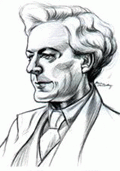Leo Baekeland
It's in our homes. It's the most common material in the workplace. Sometimes it's even in our bodies. We may be in the Information Age, but it's hard to believe that we are not living squarely in the Plastic Age.
The very name "plastic" means versatility. You can bend it, mold it, model it, twist it, and ply it in a number of different ways. The finished product can be a soft and airy foam or a hard and strong compound rivaling the sturdiest metal alloys. In its many forms, plastic has forever changed the way we live.
The first in the long line of man-made plastics was called Bakelite, after its inventor, Leo Baekeland. He was born on November 14, 1863 in Ghent, Belgium and studied chemistry at the University of Ghent in 1880, after graduating with honors from Ghent Municipal Technical School, who provided a scholarship for him to do so. He acquired a PhD maxima cum laude at the age of 21. He became Professor of Chemistry at Ghent in 1889 and shortly after, married and moved to New York, where worked as a consulting-chemist. In 1891 he patented the invention, Velox, a photographic paper that could be developed under artificial light, the first commercially successful photographic paper. Many years of work in his chemistry lab in Yonkers, New York, led him in 1907 to the invention of the first synthetic polymer (plastic), made by linking small molecules together to make large ones.

Baekeland made his new material by mixing the disinfectant carbolic acid (phenol) with the strong-smelling preservative formaldehyde to make a third material that was nothing like the original two. It turned out to be a substance that would change the world.
Some of the early uses for plastic were to make things like radio cabinets, buttons, billiard balls, pipe-stems, toilet seats, airplane parts, and the object of Baekeland's research, shellac. Baekeland's trick was to take the resin produced by the two chemicals and heat it under pressure to produce a soft solid that could be molded, hardened, or powdered, and set under pressure. With this innovation, the plastic revolution was underway.
Baekeland founded General Bakelite Co. in 1910, and by 1922, the Redmanol Chemical Products Co., founded by L.V. Redman, was merged to create the Bakelite Corporation. He became a professor at Columbia University in 1917 and became a U.S. Citizen two years later. He held more than 100 patents in his lifetime and received many awards and honors, including the Perkin Medal in 1916 and the Franklin Medal in 1940. Baekeland died on February 23, 1944 in Beacon, New York at age 80. In 1978 he was posthumously inducted into the National Inventors Hall of Fame at Akron, Ohio.


